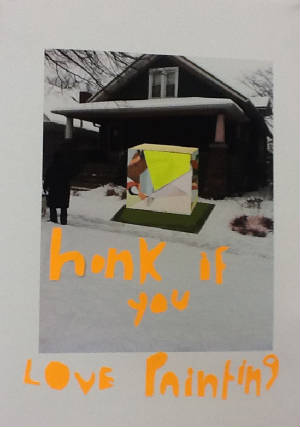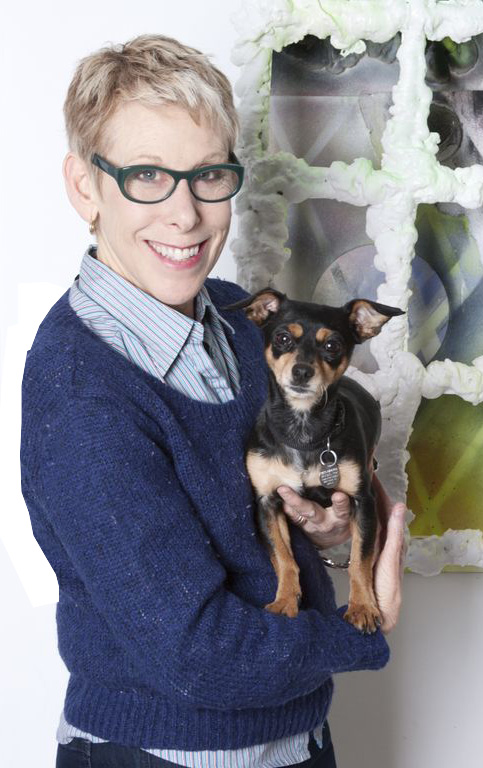I have a solitary artistic practice. When I make things, I am by myself
in the studio--introspective and internal. However, I love putting exhibitions together and being able to exhibit friends
and artists from all over the world, to make something interesting and poetic happen and create opportunities for others.
I operated, with a group of friends, an alternative space when I was a graduate student in San Francisco and have curated
about 15 exhibitions since. They have been in university galleries, alternative spaces and commercial galleries across the
country. One year I curated two exhibitions in unrented storefronts in malls in Pasadena and Eagle Rock, CA. I moved to Chicago 6
years ago and wanted to actively engage in the artistic community here. I also wanted to bring something very different to
the neighborhood in which I live. I have moved at least every five years during my adult life, and I don’t want to move
anymore. I plan on staying in the Chicago area, and want to make a fertile ground in which I can grow, as a person and as
an artist. I want to be part of my local culture. For a long time I wasn't sure what form my involvement would take. It took
a while to figure out exactly what I could offer. Chicago is rich with artist run spaces and community based projects, and
I didn’t want to simply duplicate what was happening already. I started Terrain in 2011. I had just built a studio in my back yard. Since I teach, my work time and
space are valuable, so I didn't want to have a gallery in my studio. I have a collection of art in my home, and I didn't want
to take that down every month to have exhibits or to have to tend a more traditional gallery space. For a while I considered
having a garden in the front yard as my art practice and imagined that the neighborhood children would gladly work in the
garden with me. I quickly realized that gardens and farming projects were already abundant, that my front yard is small --
only 10 by 15 feet and without much sun -- that my neighbor’s children would probably rather be playing than working
on a “farm,” and that I am a terrible gardener.
I got the idea for a front yard project space while hanging out
with my students at Michelle Grabner’s and Brad Killiam’s Poor Farm, a Kunsthalle in rural Wisconsin. The Poor
Farm Experiment, as it’s called, invites artists to do outdoor projects every August, among other events. I was invited
to participate in 2010 and made a portable pond with a working waterfall out of Styrofoam and glitter that was both a sculpture,
a seating area, and a classic garden water element. Making that piece led my work in a new direction, and my new work has
similarities with Terrain in that each piece is a hybrid of functional objects and art genres. I thought that I could offer
a similar opportunity for expansion to others and became excited about inviting artists to produce outdoor projects that engaged
the site of my front yard. A front yard is defined by its boundaries and property lines but can be seen all day long, all
year round. Because of the parameters of the space and the associations attached to a yard, artists have been able to play
and create projects that they wouldn’t normally. The process of choosing artists is informal; I ask people I like or whom I want to get to know
better and those whose studio practice is flexible enough for them to be willing to play. I invite participants who
have a spirit of generosity and encourage people to take aspects of yard art or of their experiences in the country, city
or suburbs, and to make that the subject - to invert something that's usually found in a yard and transform it into something
unfamiliar.
For
example, one of the first projects was by Stephanie Brooks, an artist who uses language and signage in her work. She
made red yard signs that were similar to the political campaign yard signs you see everywhere, but were printed with part
of Shakespeare's Sonnet 116, a declaration about love. It was magnificent to have that in the front yard next to my neighbor's
pro union and other political signs. Her work holds the honor of being the only project that inspired a theft. Someone took
a sign, which we replaced. The piece punctured expectations and replaced didactic messages with poetry. That's what I think
people aim for when they make projects for Terrain and that's what I encourage the invited artists to do.
In January, Jin Lee, a traditional photographer whose work often documents nature, collected
and arranged used Christmas trees to make a forest in the front yard. This project is brilliant, elegant and simple, and connected
with her own photographs of trees that she has been producing for years. She made a beautiful “invitation to participate”
card and we put them in the mailboxes of houses within a five - block radius that had Christmas trees in their windows. Over
had 14 families responded and dropped off their Christmas trees. This gave me the opportunity to invite those families to
the opening party and increase the neighborhood’s investment in Terrain’s projects. We extended our request for
trees on Facebook, and so opened up the project citywide. Jin Lee created a book of tree photographs that she will give out
during the reception and that is available for purchase online. Because it is a sculptural installation, Jin probably would
never instigate a piece like this were it not for Terrain. I'm very happy when that happens.

Anna Kunz, Honk If You Love Painting, Terrain,
Chicago.
In another project, Joan Giroux made
a sandbox for the front yard and provided toys for the local children to play with. A soundtrack of a text that her mother
had written and other memories of childhood experiences played. Public readings on death and mourning were held throughout
the run of the exhibition, creating a series of diverse experiences. After the show, the sandbox was donated to a neighbor’s
front yard and is still accessible to the public.
Just as the art is specific to my yard,
Terrain is specific to Oak Park, a “village” that is mostly filled with houses and yards. Oak Park, besides being
the former home of Frank Lloyd Wright as well as Ray Kroc, founder of McDonald’s, is racially diverse, small and multi-generational.
There is an active walking culture here that was a huge factor in creating this kind of space. I am interested in accidental
audiences: the kids who attend the elementary school across the street, the neighbors walking their dogs, the couple taking
their evening exercise, the children playing after school. Other audiences for Terrain events consist of artists, the friends
and family of the exhibitor, collectors, gallerists and curators. These people come to the opening party. Often people drive
by looking for the projects, some read about the art on Facebook or tumblr and seek it out, neighbors bring neighbors or parents
bring their kids. Terrain had a “float” in the Oak Park Fourth of July Parade. We attached Claire Ashley’s
inflatable sculpture to the top of our car and paraded alongside the high school marching band. The car nearly overheated
and we almost lost the inflatable, but it was great fun. The best part was that the parade watchers, mostly kids, kept asking
“what is it, what is it?”. The artist shouted back “it’s art”; the kids instantly got it and
many began following us in the parade.
The neighborhood location allows for an intimate engagement
with the art. My experience of galleries has been that the more important they are, the more inhospitable and chilly the atmosphere
is. There’s no place to sit and chat. Terrain is the absolute opposite. When you are inside at one of the opening parties
you are in my house. You are invited to eat and drink. I cook lots of really good food – I’ve gotten very good
at cooking for large groups of people and I love it. The food, the event and the space itself are my offerings. The
aspect of hospitality has become a personally satisfying part of running Terrain. One can sit around and talk to people who
may or may not know anything about the art. One can sit on the porch and look at the artwork from that angle, hang outside,
do what ever you want. If someone wants to talk to me and come into the house during the run of the show they can contact
me via Facebook and arrange time to come over and visit, or leave a note in my mailbox, but the art is always visible from
the street.
No money changes hands at Terrain. Right now the artists produce their own projects.
I’m not yet sure if I will apply for grants. I like the independence the artists and I have with the space operating
as it is, but I am sure that the artists would like support for the production of their projects.
Stephanie Brooks, Yard Signs, vinyl and wood, Terrain, Chicago.
Terrain also lives on Facebook and Tumblr. I consider these online
spaces as another kind of front yard. The work is represented by photographs that I take on my phone and upload as if Terrain
was any tourist destination. People post about the works, adding an interactive dimension to the project. The online
presence historicizes Terrain and gives it an overall shape, extending the duration of the projects. When you are physically
in a Terrain installation, eating, talking, viewing, you are naturally aware that both the experience and the artwork are
temporal. Online, you can see the project all of the time and in context to all the other projects. In that way, Terrain itself
becomes understood as important as the individual artworks, Terrain itself is a work that expands and contracts over time.
Terrain is not intended as an engagement with relational aesthetics. I don’t view it as my art -- I understand it as
a shifting entity formed by multiple events that the artists set in motion. In 2012 Terrain participated in the MDW
ArtFair in Chicago, a fair that focuses on artist-run spaces. I showed documentation of all the Terrain projects – the
preparatory drawings the artists made, artifacts from their pieces and photos of the installations. The overall effect was
that of a trade show display or a real estate office. Handouts that described each piece were available. This coming
year, Terrain will host a biennial. Many of my neighbors have agreed to let artists use their yards for the month of September,
so we will have many artworks in many yards at the same time. Oak Parkers love block parties, so the reception will be an
open block party with performances, food and music. We might even have fireworks.
© Sabina Ott 2013

Sabina Ott
is an artist living in Oak Park, IL. She is Professor of Art at Columbia College Chicago and, in addition to making things
and teaching, enjoys curating and gardening.
http://terrainexhibitions.tumblr.com
|
